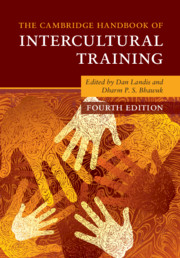Book contents
- The Cambridge Handbook of Intercultural Training
- Reviews
- The Cambridge Handbook of Intercultural Training
- Copyright page
- Dedication
- Frontispiece
- Contents
- Figures
- Tables
- Editors and Contributors
- Foreword
- Preface
- 1 Introduction and Theoretical Framework
- Part I Theoretical Foundations of Intercultural Training
- 2 Harry Triandis’s Contributions to Intercultural Training as a Field of Research
- 3 Interdisciplinary History of Intercultural Communication Studies
- 4 Culture Theories and Intercultural Training
- 5 An Analysis of Methods for Intercultural Training
- 6 Intercultural Simulations
- 7 Toward a Social Network Theory of Reentry
- 8 Intractable Conflict, Delegitimization, and Intercultural Training
- 9 Evaluation of Cross-Cultural Training
- Part II Practice of Intercultural Training
- Part III Indigenous Psychology and Intercultural Training
- Part IV New Interdisciplinary Approaches to Intercultural Training
- Part V Summing Up
- Index
- References
8 - Intractable Conflict, Delegitimization, and Intercultural Training
from Part I - Theoretical Foundations of Intercultural Training
Published online by Cambridge University Press: 18 September 2020
- The Cambridge Handbook of Intercultural Training
- Reviews
- The Cambridge Handbook of Intercultural Training
- Copyright page
- Dedication
- Frontispiece
- Contents
- Figures
- Tables
- Editors and Contributors
- Foreword
- Preface
- 1 Introduction and Theoretical Framework
- Part I Theoretical Foundations of Intercultural Training
- 2 Harry Triandis’s Contributions to Intercultural Training as a Field of Research
- 3 Interdisciplinary History of Intercultural Communication Studies
- 4 Culture Theories and Intercultural Training
- 5 An Analysis of Methods for Intercultural Training
- 6 Intercultural Simulations
- 7 Toward a Social Network Theory of Reentry
- 8 Intractable Conflict, Delegitimization, and Intercultural Training
- 9 Evaluation of Cross-Cultural Training
- Part II Practice of Intercultural Training
- Part III Indigenous Psychology and Intercultural Training
- Part IV New Interdisciplinary Approaches to Intercultural Training
- Part V Summing Up
- Index
- References
Summary
One of the major challenges of intercultural training refers to the question, how it can be implemented in intractable violent and persistent conflict. Usually, societies in conflict do not recognize the need for intercultural training because they concentrate on mutual delegitimizing and harming each other. Also, they do not strive to promote their relations as a goal stands in their priority. The current chapter suggests that intercultural training under conflict is possible but involves a long process. During the conflict, and especially during times of its de-escalation, it is possible to begin to provide information about the rival. In further stages, especially during negotiations for its peaceful resolution, it is possible to initiate encounters between rival group members. In order to reach the desired outcomes of intercultural training, groups in conflict should get to know each other, not only in conflict-related contexts but also in everyday humane contexts. It is a long process that requires the mobilization and involvement of all institutions. By training that provides neutral and positive information that humanizes, personifies, and legitimizes the opposite group, rival groups can formulate their perceptions towards their adversary in a way that considers its multidimensional aspects, thereby contributing to changing delegitimization of the rival group.
- Type
- Chapter
- Information
- The Cambridge Handbook of Intercultural Training , pp. 306 - 333Publisher: Cambridge University PressPrint publication year: 2020
References
- 1
- Cited by



